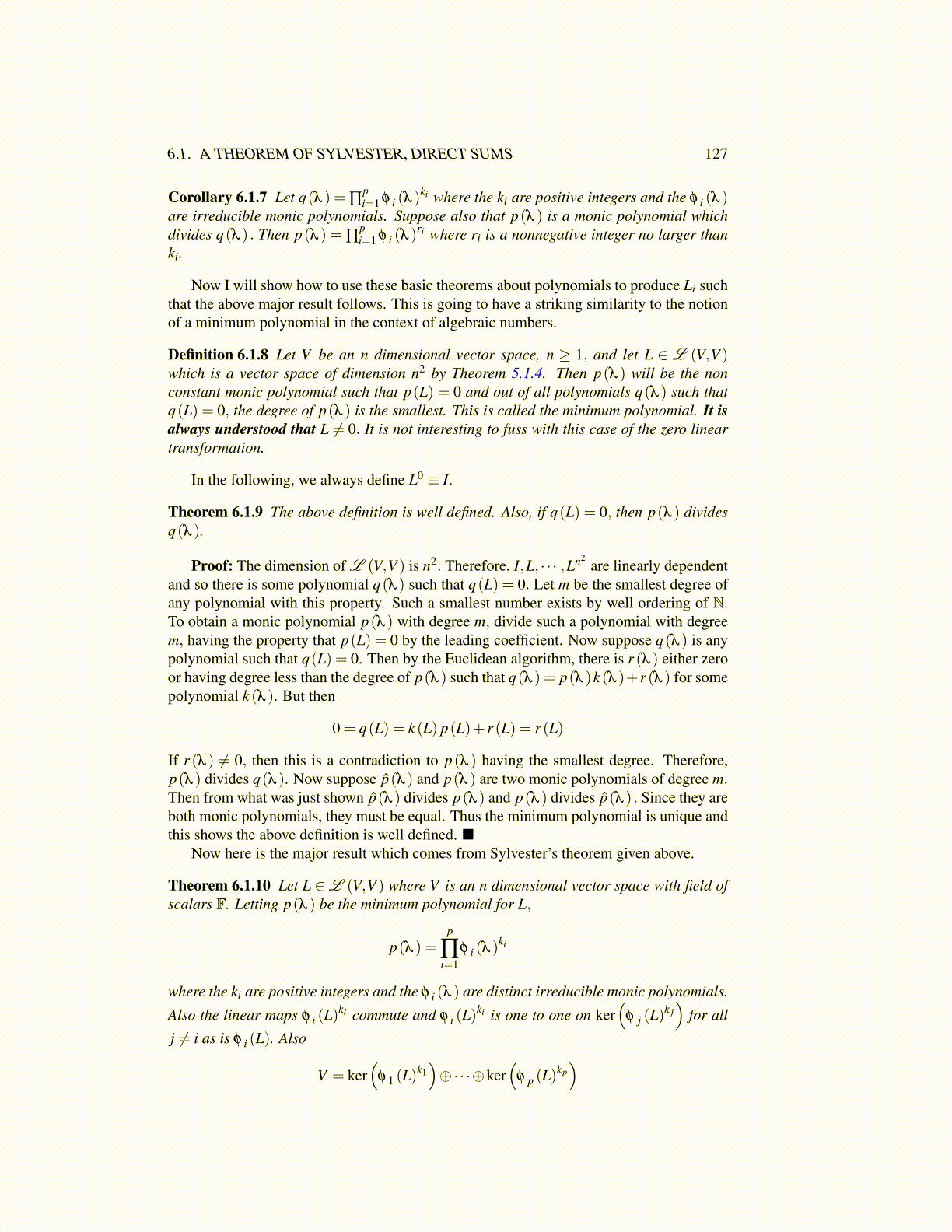
6.1. A THEOREM OF SYLVESTER, DIRECT SUMS 127
Corollary 6.1.7 Let q(λ ) = ∏pi=1 φ i (λ )
ki where the ki are positive integers and the φ i (λ )are irreducible monic polynomials. Suppose also that p(λ ) is a monic polynomial whichdivides q(λ ) . Then p(λ ) = ∏
pi=1 φ i (λ )
ri where ri is a nonnegative integer no larger thanki.
Now I will show how to use these basic theorems about polynomials to produce Li suchthat the above major result follows. This is going to have a striking similarity to the notionof a minimum polynomial in the context of algebraic numbers.
Definition 6.1.8 Let V be an n dimensional vector space, n ≥ 1, and let L ∈ L (V,V )which is a vector space of dimension n2 by Theorem 5.1.4. Then p(λ ) will be the nonconstant monic polynomial such that p(L) = 0 and out of all polynomials q(λ ) such thatq(L) = 0, the degree of p(λ ) is the smallest. This is called the minimum polynomial. It isalways understood that L ̸= 0. It is not interesting to fuss with this case of the zero lineartransformation.
In the following, we always define L0 ≡ I.
Theorem 6.1.9 The above definition is well defined. Also, if q(L) = 0, then p(λ ) dividesq(λ ).
Proof: The dimension of L (V,V ) is n2. Therefore, I,L, · · · ,Ln2are linearly dependent
and so there is some polynomial q(λ ) such that q(L) = 0. Let m be the smallest degree ofany polynomial with this property. Such a smallest number exists by well ordering of N.To obtain a monic polynomial p(λ ) with degree m, divide such a polynomial with degreem, having the property that p(L) = 0 by the leading coefficient. Now suppose q(λ ) is anypolynomial such that q(L) = 0. Then by the Euclidean algorithm, there is r (λ ) either zeroor having degree less than the degree of p(λ ) such that q(λ ) = p(λ )k (λ )+r (λ ) for somepolynomial k (λ ). But then
0 = q(L) = k (L) p(L)+ r (L) = r (L)
If r (λ ) ̸= 0, then this is a contradiction to p(λ ) having the smallest degree. Therefore,p(λ ) divides q(λ ). Now suppose p̂(λ ) and p(λ ) are two monic polynomials of degree m.Then from what was just shown p̂(λ ) divides p(λ ) and p(λ ) divides p̂(λ ) . Since they areboth monic polynomials, they must be equal. Thus the minimum polynomial is unique andthis shows the above definition is well defined. ■
Now here is the major result which comes from Sylvester’s theorem given above.
Theorem 6.1.10 Let L ∈L (V,V ) where V is an n dimensional vector space with field ofscalars F. Letting p(λ ) be the minimum polynomial for L,
p(λ ) =p
∏i=1
φ i (λ )ki
where the ki are positive integers and the φ i (λ ) are distinct irreducible monic polynomials.
Also the linear maps φ i (L)ki commute and φ i (L)
ki is one to one on ker(
φ j (L)k j)
for all
j ̸= i as is φ i (L). Also
V = ker(
φ 1 (L)k1)⊕·· ·⊕ker
(φ p (L)
kp)